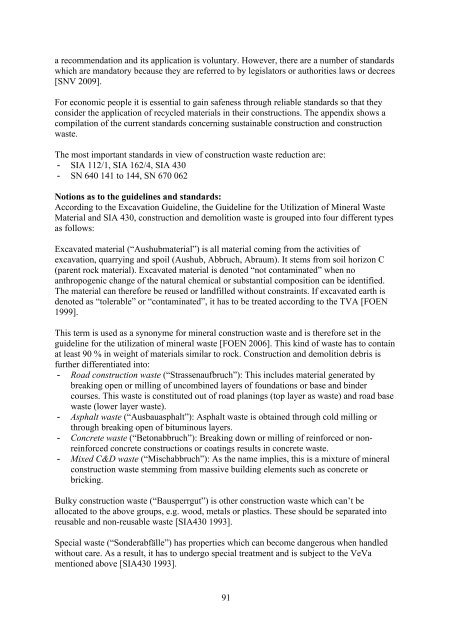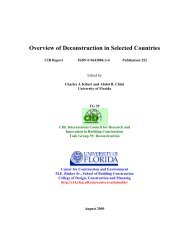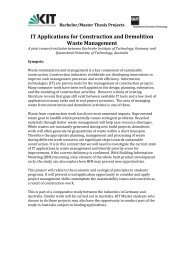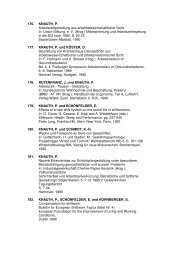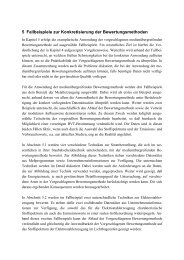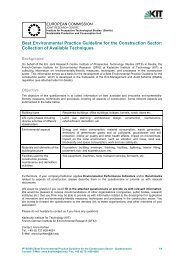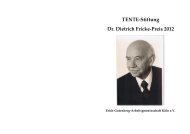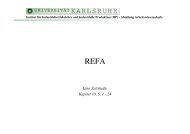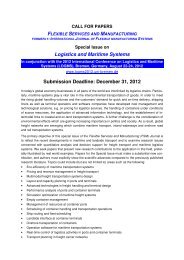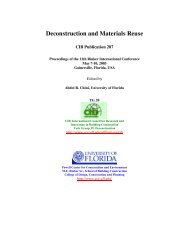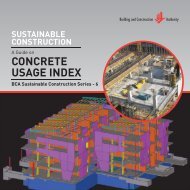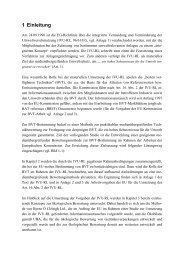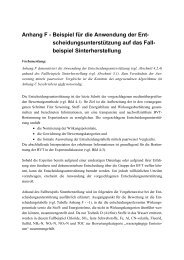Waste reduction final report -4 - Test Input
Waste reduction final report -4 - Test Input
Waste reduction final report -4 - Test Input
Create successful ePaper yourself
Turn your PDF publications into a flip-book with our unique Google optimized e-Paper software.
a recommendation and its application is voluntary. However, there are a number of standards<br />
which are mandatory because they are referred to by legislators or authorities laws or decrees<br />
[SNV 2009].<br />
For economic people it is essential to gain safeness through reliable standards so that they<br />
consider the application of recycled materials in their constructions. The appendix shows a<br />
compilation of the current standards concerning sustainable construction and construction<br />
waste.<br />
The most important standards in view of construction waste <strong>reduction</strong> are:<br />
- SIA 112/1, SIA 162/4, SIA 430<br />
- SN 640 141 to 144, SN 670 062<br />
Notions as to the guidelines and standards:<br />
According to the Excavation Guideline, the Guideline for the Utilization of Mineral <strong>Waste</strong><br />
Material and SIA 430, construction and demolition waste is grouped into four different types<br />
as follows:<br />
Excavated material (“Aushubmaterial”) is all material coming from the activities of<br />
excavation, quarrying and spoil (Aushub, Abbruch, Abraum). It stems from soil horizon C<br />
(parent rock material). Excavated material is denoted “not contaminated” when no<br />
anthropogenic change of the natural chemical or substantial composition can be identified.<br />
The material can therefore be reused or landfilled without constraints. If excavated earth is<br />
denoted as “tolerable” or “contaminated”, it has to be treated according to the TVA [FOEN<br />
1999].<br />
This term is used as a synonyme for mineral construction waste and is therefore set in the<br />
guideline for the utilization of mineral waste [FOEN 2006]. This kind of waste has to contain<br />
at least 90 % in weight of materials similar to rock. Construction and demolition debris is<br />
further differentiated into:<br />
- Road construction waste (“Strassenaufbruch”): This includes material generated by<br />
breaking open or milling of uncombined layers of foundations or base and binder<br />
courses. This waste is constituted out of road planings (top layer as waste) and road base<br />
waste (lower layer waste).<br />
- Asphalt waste (“Ausbauasphalt”): Asphalt waste is obtained through cold milling or<br />
through breaking open of bituminous layers.<br />
- Concrete waste (“Betonabbruch”): Breaking down or milling of reinforced or nonreinforced<br />
concrete constructions or coatings results in concrete waste.<br />
- Mixed C&D waste (“Mischabbruch”): As the name implies, this is a mixture of mineral<br />
construction waste stemming from massive building elements such as concrete or<br />
bricking.<br />
Bulky construction waste (“Bausperrgut”) is other construction waste which can’t be<br />
allocated to the above groups, e.g. wood, metals or plastics. These should be separated into<br />
reusable and non-reusable waste [SIA430 1993].<br />
Special waste (“Sonderabfälle”) has properties which can become dangerous when handled<br />
without care. As a result, it has to undergo special treatment and is subject to the VeVa<br />
mentioned above [SIA430 1993].<br />
91


